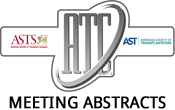2015 American Transplant Congress
Early Vs. Late Acute Antibody Mediated Rejection Among Renal Transplant Recipients in Terms of Its Response to Rituximab Therapy-Single Center Expereince
Nephrology, OTC of Kuwait, kuwait, Kuwait.
IntroductionThere are no comparable trials concerning the use of rituximab among renal transplant recipients with acute antibody mediated rejection.Aim of the study:We aimed to compare…2015 American Transplant Congress
Marrow Mesenchymal Stem Cells Attenuate Immune Rejection in Murine Lung Allograft
Objectives:The inherent immunosuppressive properties and low immunogenicity of mesenchymal stems cells (MSCs) suggested their therapeutic potential in transplantation. In this study we investigated if systematic…2015 American Transplant Congress
The Association Between Donor & Recipient Gene Variants and Tacrolimus Safety & Efficacy in a Diverse Cohort of Kidney Transplant Recipients
Medical University of South Carolina, Charleston, SC.
Previous studies have associated donor P-glycoprotein (PGP) gene variants (ABCB1) with risk of developing CNI-toxicity, while also establishing recipient CYP3A5*1 and ABCB1 gene variants are…2015 American Transplant Congress
Inadequate Overall Immunosuppression Is a Risk for Late Acute Rejection Despite Alemtuzumab Induction in Simultaneous Pancreas Kidney Transplant Recipients
Introduction: Simultaneous pancreas-kidney transplantation (SPK) has become the treatment of choice for patients with end-stage renal disease due to Type 1 Diabetes Mellitus. SPK is…2015 American Transplant Congress
Characterization of Natural T Effector Memory Cells Specific for Collagen type V, k-α-1-Tubulin and Vimentin
Background: Injury and repair processes are highly controlled, common occurrences of healthy tissue remodeling. During this process, cellular antigens that are not normally exposed to…2015 American Transplant Congress
Evaluation of Serum sCD30 as a Predictor in Kidney Transplant Recipients
Objective To explore the significance of serum CD30 in predicting acute rejection and pneumonia in kidney transplant recipients. Methods A total of 106 kidney transplant…2015 American Transplant Congress
Evaluation of a Three-Dose Basiliximab Induction Immunosuppression Regimen in Adult Heart Transplant Recipients
University of Virginia Health System, Charlottesville, VA.
Background: Calcineurin inhibitors (CNI) are essential agents in most orthotopic heart transplantation (OHT) anti-rejection regimens. However, nephrotoxicity limits their use in the immediate post-OHT period,…2015 American Transplant Congress
Activated T Regulatory Cells Escape Death by Increasing Cytoplasmic Serine Protease Inhibitor 6 (SPI6)
Renal/ Transplantation Research Center, Brigham and Women's Hospital, Boston, MA.
Regulatory T cells (Tregs) can employ a granzyme B (GrB)-dependent mechanism to mediate suppression of effector cells by inducing their apoptosis. In this study we…2015 American Transplant Congress
Short- and Long-Term Outcomes of Mycophenolate Versus Azathioprine in a Large Cohort of Renal Transplant Recipients
1Barnes-Jewish Hospital, St. Louis; 2Washington University School of Medicine, St. Louis.
Purpose: Early studies comparing mycophenolate mofetil (MMF) to azathioprine (AZA) post-renal transplantation demonstrated superiority of MMF over AZA for the prevention of acute rejection (AR).…2015 American Transplant Congress
The Impact of Acute Rejection on Liver Transplant Survival in the New Millennium
Background: Based on pre-2000 data, acute rejection (AR) has long been considered clinically less significant in liver transplant (LT) vs. other organ recipients (Charlton et…
- « Previous Page
- 1
- …
- 163
- 164
- 165
- 166
- 167
- …
- 172
- Next Page »
